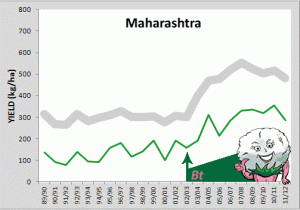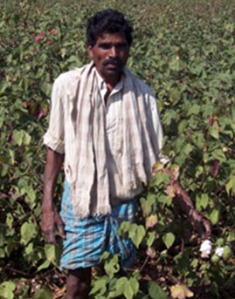 Of all the crops and countries in GMO controversies today, few are as important than Bt cotton in India. GMO debates keep going back to small farmers and developing countries, and India has by far the most small farmers planting GM seeds. (In Brazil and Argentina, which account for most of the GM plantings in the developing world, most of the GM seeds are planted by large commercial soybean growers.)
Of all the crops and countries in GMO controversies today, few are as important than Bt cotton in India. GMO debates keep going back to small farmers and developing countries, and India has by far the most small farmers planting GM seeds. (In Brazil and Argentina, which account for most of the GM plantings in the developing world, most of the GM seeds are planted by large commercial soybean growers.)
The ISAAA has recently put out a series of publications on the “remarkable success of Bt cotton in India” (see an example). Articles by economists routinely attribute major yield gains in Indian cotton to Bt. In a recent interview with Down to Earth I was asked to respond to the claim by a seed industry spokesman that Bt cotton showed “how a technology can double yield of a crop in 6-7 years.”
If all this is true, it is very important. Is it? Well I’m a data guy and I happen to have the latest data on Indian Bt cotton (courtesy of the International Cotton Advisory Board). First let me say that I have already discussed the controversy over Bt cotton causingfarmer suicides: the data just don’t support it. But if we take a similarly objective look at the data on Bt cotton’s “remarkable success,” there are some equal surprises in store, and a few inescapable ugly facts.
India approved Bt cotton in 2002; 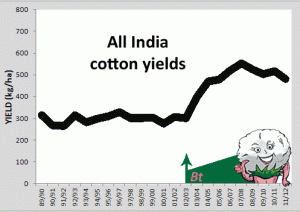 now it accounts for 92% of all Indian cotton. Average nationwide cotton yields went from 302 kg/ha in the 2003/3 season to a projected 481 kg/ha in 2011/12 — up 59.3% overall. This chart shows the trends in yields, which took off after Bt was introduced in 2002 (as we are constantly reminded by GMO enthusiasts).
now it accounts for 92% of all Indian cotton. Average nationwide cotton yields went from 302 kg/ha in the 2003/3 season to a projected 481 kg/ha in 2011/12 — up 59.3% overall. This chart shows the trends in yields, which took off after Bt was introduced in 2002 (as we are constantly reminded by GMO enthusiasts).
(The depiction of Bt cotton as a coquettish boll is courtesy of the ISAAA’s Mandy and Fanny, subject of literary criticism in an earlier post.)
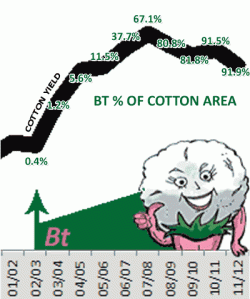 The problem is that while yields did take off right after Bt cotton was approved, this was well before hardly anyone was actually planting Bt cotton! Look at this graph showing the yearly percentages of all Indian cotton land planted to Bt cotton. Now here’s ugly fact #1: Most of the yield increase happened between 2002-5 when Bt comprised between 0.4-5.6% of India’s cotton. Obviously Bt couldn’t have accounted for more than a tiny speck of the national rise.
The problem is that while yields did take off right after Bt cotton was approved, this was well before hardly anyone was actually planting Bt cotton! Look at this graph showing the yearly percentages of all Indian cotton land planted to Bt cotton. Now here’s ugly fact #1: Most of the yield increase happened between 2002-5 when Bt comprised between 0.4-5.6% of India’s cotton. Obviously Bt couldn’t have accounted for more than a tiny speck of the national rise.
The graphs also show that — and here comes ugly fact #2 — in the last 4 years, as Bt has risen from 67% to 92% of India’s cotton, yields have dropped steadily.
Could it be that there is more going on than just Bt adoption? KR Kranthi, director of the Central Institute for Cotton Research (and as knowledgeable a person on Indian cotton as you are likely to find), writes that “While there is a general perception that Bt cotton technology was singularly responsible for the dramatic improvement of cotton fortunes in India, it is pertinent to examine other probable factors that may have contributed to the higher yields.”
One issue is the spread of poorly regulated private hybrid seeds that require pesticides; cotton farmers have been on a pesticide treadmill ever since. The hallmark of the pesticide treadmill is short-term yield increases, and the yield increases in the early 2000′s probably had more to do with conventional pesticides than Bt. KR Kranthi writes that the insecticide imidacloprid is
used as a seed treatment for protection against sap-sucking insects. Even a naïve student in India would know that none of the vast majority of Bt hybrids would have been able to sustain that onslaught of leaf hopper infestation without seed treated with imidacloprid. Gaucho, as it was known commercially, has been used in India since 2000 and was known to have contributed to at least 25% to 30% yield enhancement in the conventional hybrids, long before Bt cotton was introduced in the country. Since 2002, every Bt cotton seed has been treated with the highly effective insecticide, imidacloprid…
 But it’s hard to generalize about a country that is as large and diverse as India, and those countrywide averages are hiding very different local patterns. This chart shows the yield trends in the 8 states with significant cotton crops; the trends are all over the map. Pretty messy. So let’s zero in on the 4 biggest cotton producers (the legend in this chart gives their ranking based on cotton acres in 2011).
But it’s hard to generalize about a country that is as large and diverse as India, and those countrywide averages are hiding very different local patterns. This chart shows the yield trends in the 8 states with significant cotton crops; the trends are all over the map. Pretty messy. So let’s zero in on the 4 biggest cotton producers (the legend in this chart gives their ranking based on cotton acres in 2011).
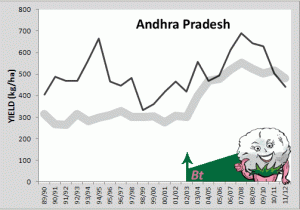 Let’s start with Andhra Pradesh, where I have been doing research for the last 12 years. Yields did go up when Bt came along, but the upward trend clearly started after the 1997/8 season; farmers didn’t adopt Bt in significant numbers until 2005/6 which is 8 years after the yields started climbing. (More on the A.P. story is available here.) Then the ugly fact #3: since 2007, yields in AP have dropped back to below where they were before farmers started adopting Bt cotton.
Let’s start with Andhra Pradesh, where I have been doing research for the last 12 years. Yields did go up when Bt came along, but the upward trend clearly started after the 1997/8 season; farmers didn’t adopt Bt in significant numbers until 2005/6 which is 8 years after the yields started climbing. (More on the A.P. story is available here.) Then the ugly fact #3: since 2007, yields in AP have dropped back to below where they were before farmers started adopting Bt cotton.
Now for Maharashtra, kind of like AP but not as pronounced: yields started rising well before Bt became popular, and now have dropped back to around where they were before.
Next is Madhya Pradesh, where yields have been going down ever since the 1997/8 season. Bt cotton
doesn’t seem to have done anything to improve the steady slump.
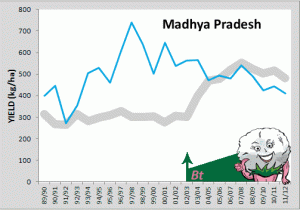
Finally we get to Gujarat, which is where the real action is. This state accounts for most of the national rise in yields after 2002/3. Nobody knows for certain how much Bt cotton was being planted in 2001-3 because there were illegal Bt seeds on many farms (it’s an interesting story). Bt, illegal or not, surely played a role in the rise in Gujarat yields. So doesn’t that surge between 2000-2005 qualify as a “remarkable success
” for Bt?
Here comes ugly fact #4: In Gujarat, the state
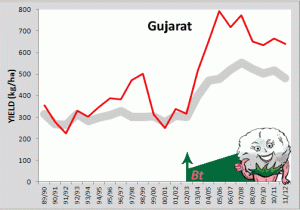
mainly responsible for India’s remarkable rise in yields, there were many factors contributing to cotton yields other than Bt. According to KR Kranthi:
It is important to consider that maximum productivity gains were obtained from the 0.6 million to 0.7 million hectares of new area under cotton in Gujarat, which had the benefits of more than 100,000 newly constructed check dams apart from the highly fertile soils that were under groundnut cultivation for several years before cotton was taken up. New technologies such as pesticides with novel modes of action…were introduced during 2001 and 2002.
Therefore, it is probable that the new pesticides, new hybrids, new micro-irrigation systems, new areas, and Bt-cotton together may have been effectively contributing to the enhanced rate of production and productivity. The role of Bt cotton in effectively protecting the crop from bollworms… cannot be underestimated, but need not be overhyped either.
I have read that the army of activists writing on GMO’s in India try to avoid the facts of the case. I think on some issues –like the suicide narrative — that’s a fair charge. But the counter-narrative of Bt cotton’s “remarkable success” also needs to he held up to the facts, and when you do, it gets ugly very quickly.
Bt did not “double yields” in 5 years. National yields did rise from 302 to 554 kg/ha (up 84%) in the first 5 years after Bt was released, but almost all of that rise occurred in 2003/4 (when only 1.2% of the cotton was Bt) and 2004/5 (when only 5.6% of the cotton was Bt). In short, Bt couldn’t have been responsible for the rise.
A more likely explanation for a rise in national yields in the early 2000s were the short-term gains from insecticides for sap-sucking pests.
Bt adoption didn’t top 10% until 2005/6; since then, adoption has climbed to 92%. In that same period from 2005 to the present, national yields rose from 478 to 481 kg/ha — up 1%.
In none of the top 4 cotton-producing states do the trends fit the claim that Bt cotton has boosted yields. Even in Gujarat, where yield gains were most dramatic, the adoption of Bt was only one of several key changes in cotton production.
Over the last 4 seasons, with Bt adoption topping 90%, yields have dropped 13.2%. In AP, where I have watched the Bt saga closely, yields are lower than they were before Bt became popular. Now that’s ugly.
'庫間 > 해외자료' 카테고리의 다른 글
| 고기는 신경쓰지마, 채소를 충분히 먹자 (0) | 2012.02.15 |
|---|---|
| 생태계 경제학 -우리가 자연에 가격을 매길 수 있을까 (0) | 2012.02.15 |
| 몬산토는 20만 농부의 자살에 책임이 없는가 (0) | 2012.02.15 |
| 각지의 농부를 위해, 작은 것이 (여전히) 아름답다 (0) | 2012.02.15 |
| 유전자조작 옥수수와 함께 사용하는 살충제는 벌에게 매우 해롭다는 연구 (0) | 2012.02.15 |
